This quick vegan almond ricotta cheese recipe has the perfect acidity and texture. With curds from raw almonds, cheezy nutritional yeast, and an herby kick from chives, it will become a staple in your kitchen!

Jump to:
🧀 What is Ricotta anyway?
Without a doubt, ricotta is the most forgiving cheese to substitute for vegans. That's likely because it is considered a whey cheese! The real thing itself is made with mostly whey and only a tiny bit of curd.
Shockingly, some don't even consider it cheese at all:
This soft, sweet, white cheese is made from what is left over after making other cheeses. Strictly speaking, ricotta is not really considered a cheese, but a latticino—which means a dairy by-product—just as cow or buffalo milk mozzarellas are. Basically ricotta is made from whey—that is, the watery liquid that remains after cow, sheep or goat cheese is made.
DeLallo
Whether you still consider it cheese or not—there's no denying almond ricotta cheese can be as versatile as it is delicious!
👩🏻🍳 How to make vegan ricotta
Ricotta is likely the easiest "cheese" to replicate using only plants. Here's how:

Slivered Almonds
This one is a non-negotiable. Raw, slivered almonds are perfect for recreating the fat-and-protein-rich cheese curds without becoming too soft. You don't even need to soak them! In fact, soaking makes it worse. I'm telling you, we're cutting corners all around with this recipe and getting away with it.
Whole almonds without their skin are fine too as long as you have a powerful blender like a Vitamix. Basically, we want raw almonds with no skin that can easily be blended without soaking. Slivered almonds are absolutely perfect for this.
Lemon Juice
We need to mimic the lactic acid found in regular ricotta to bring in that tartness. Lemons are great for the job! Their citric acid sharpens this almond cheese and you can adjust to your taste easily.
Simply substitute with the powdered citric acid if necessary. 1 tablespoon of lemon juice roughly equals ¼ teaspoon of citric acid.
Nutritional Yeast
Not a deal-breaker if you don't have some, but it certainly elevates the flavor!
Salt
Recipe written per table salt volume measurements, double if using kosher salt (same weight).
You may skip the salt altogether for health reasons, of course. Additionally, if you'd like to use this ricotta in a dessert recipe, either omit the salt or use a quarter of what the recipe ingredient amounts say.
Water
This is the trickiest part of the recipe. Many of the vegan ricotta recipes I've tried started from a lower amount of water and instructed to add more if needed. The problem is, for me even the lower end water amount made it way too runny!
So in this recipe, we'll start with a very low amount of water to get the blender going and judge from there.
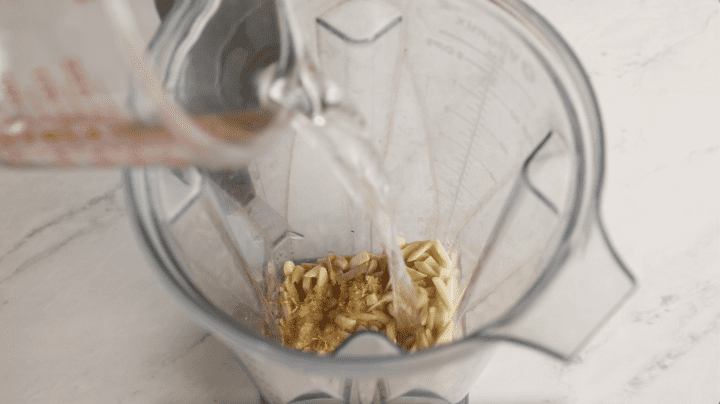
🧄 Optional Flavorings
This recipe is delicious as is, but the beauty of it is its versatility! Here are some ideas for additional flavor:
Chopped chives: Pretty much any fresh herb you like will work. Chives are my absolute favorite in cheesy/creamy/spready things though. Ricotta's no exception.
Garlic: Speaking of alliums, try it with garlic powder or fresh garlic for a change! For best results, if using fresh garlic:
- Thinly slice instead of crushing the garlic so that less allicin is released—this is a must especially if you're planning on saving the ricotta for later to avoid that pungent next-day garlic smell
- Place the sliced garlic in the lemon juice in a small bowl for a few minutes before separating them and adding the juice into the blender
Aleppo or Urfa pepper flakes: Sure, you could use regular chili flakes too but if you still haven't gotten your hands on Aleppo (pul biber) flakes yet—you're missing out big time! There's a reason it's on Christopher Kimball's (America's Test Kitchen & 177 Milk Street) TOP 5 Best Spices list!
Don't add these into the blender.
🥣 Blending the almond ricotta
We'll simply place all the ingredients into a high-speed blender and blend for 30 seconds. Scrape down the sides and repeat the process a few more times until you get that grainy yet creamy consistency. For the final touch, add in any of the flavorings and give it a mix (don't process the flavorings in the blender).
You may need to gradually add small amounts of water while blending. Just make sure not to go overboard because there is no turning back unless you have more of the other ingredients on hand!
Blender vs. Food Processor
While a food processor still works, I'd recommend sticking to a blender for this recipe. The narrow container and high-power blades help speed everything up and give you creamy ricotta.
🍽 Scaling up and storage
Depending on the size of your blender's container, you may easily double or triple the recipe if cooking for a crowd or to use later. Simply refrigerate the almond ricotta in an airtight container for up to five days.
Freezing isn't recommended as it will alter the texture for the worse upon thawing similarly to regular ricotta cheese. I'd suggest making the dish that uses the ricotta and thawing that instead. Speaking of which...
🍝 Where to use almond ricotta cheese?
So. Many. Possibilities! Gozleme is a close second, but my favorite way of using it is on cheese bread (Turkish pide / Georgian khachapuri):
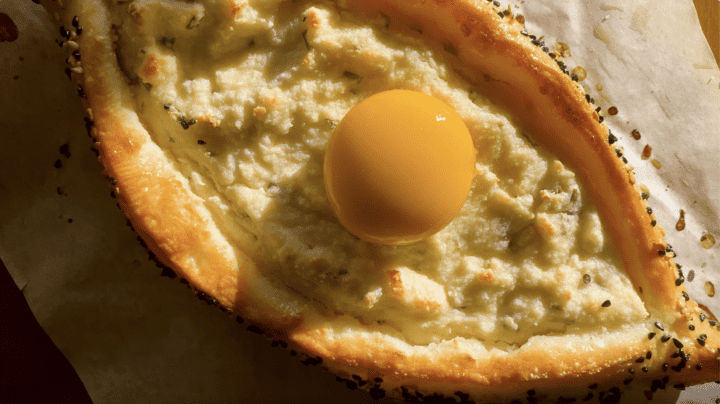
Here are some more ideas:
- On pizza 🍕
- Spread on avocado toast 🥑
- Vegan lasagna or pasta shells 🐚
- Snack on it as a dip with carrots and celery 🥕
- Mix with fresh berries or jam for a delicious dessert 🍓
- Make Pastelitos de Guayaba (guava & cheese on puff pastry) 🥐
I could keep going!
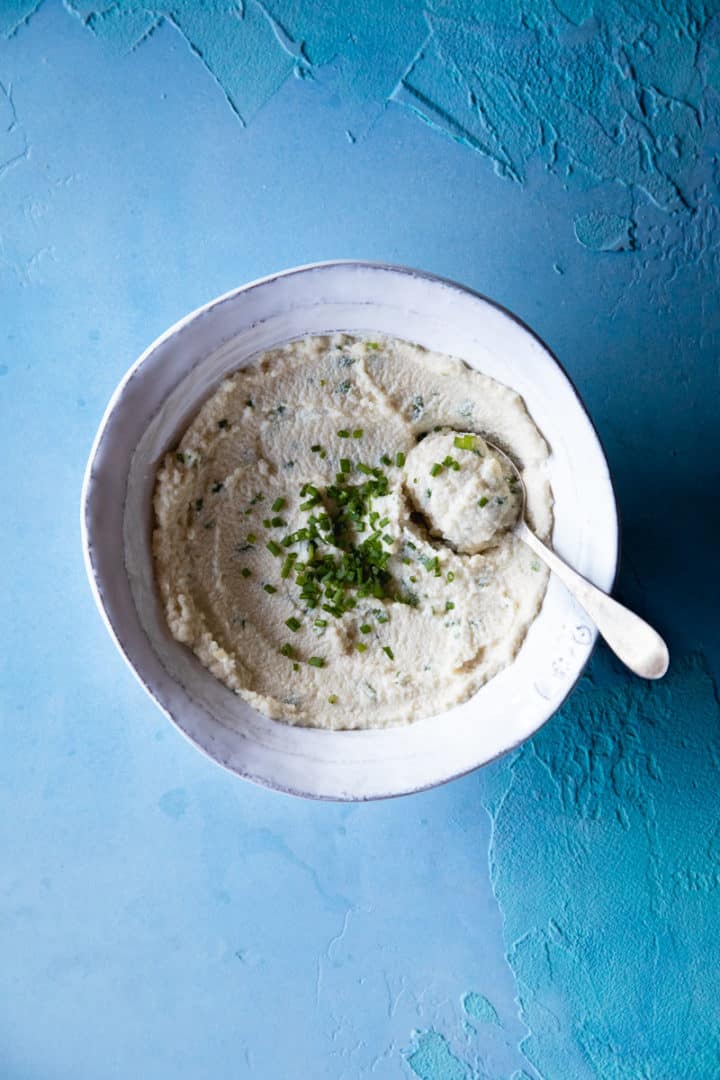
Don’t forget to let me know in the comments if you make this vegan almond ricotta recipe. I make sure to respond to each one. Afiyet olsun (bon appétit)!
You can also save it for later on Pinterest, and keep in touch with me on YouTube, Instagram, or by sending an email.
Recipe adapted from Minimalist Baker.
Print📖 Recipe
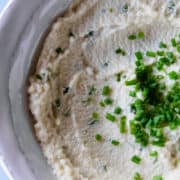
Almond Ricotta Cheese (Vegan 5-Minute Recipe!) 🧀
- Total Time: 5 minutes
- Yield: 4 cups 1x
- Diet: Vegan
Description
This quick vegan almond ricotta cheese recipe has the perfect acidity and texture. With curds from raw almonds, cheezy nutritional yeast, and an herby kick from chives, it will become a staple in your kitchen!
Ingredients
- 3 cups (315g) slivered almonds, raw (See Note 1)
- 1 tbsp nutritional yeast
- 3 tbsp lemon juice (See Note 2)
- 1 tsp table salt (See Note 3)
- ⅔ cup water + 6 tbsp to add gradually if needed
- Optional:
- 1 bunch of chives or other herbs, chopped OR
- 5 cloves of garlic, thinly sliced OR
- 1 tbsp Aleppo pepper flakes
Instructions
- Place all ingredients (slivered almonds, lemon juice, nutritional yeast, salt, and water) into a high-speed blender and blend for 30 seconds.
- Scrape down the sides and repeat the process a few more times until you get that grainy yet creamy consistency. If it’s too difficult to blend or is too thick for your liking, gradually add more water after each blend—1 tablespoon at a time.
- Adjust acidity (more lemon juice) and salt levels to taste. If using any flavorings, mix them in at this stage with a fork (do not process them in a blender).
- Enjoy on toast, on Turkish pide, in pasta shells, cheesecakes, and more! You may keep it in the refrigerator in an airtight container for up to five days.
Notes
- Almonds: Raw, slivered almonds are perfect for recreating the fat-and-protein-rich cheese curds without becoming too soft. You don't even need to soak them! Whole almonds without their skin are fine too as long as you have a powerful blender like a Vitamix. Basically, we want raw almonds with no skin that can easily be blended without soaking.
- Lemon Juice: We need to mimic the lactic acid found in regular ricotta to bring in that tartness. Lemons are great for the job! Their citric acid sharpens this almond cheese and you can adjust to your taste easily. Simply substitute with the powdered citric acid if necessary. 1 tablespoon of lemon juice roughly equals ¼ teaspoon of citric acid.
- Salt: Recipe written per table salt volume measurements, double if using kosher salt (same weight). You may skip the salt altogether for health reasons, of course. Additionally, if you'd like to use this ricotta in a dessert recipe, either omit the salt or use a quarter of what the recipe ingredient amounts say.
- Blender vs. Food Processor: While a food processor still works, I'd recommend sticking to a blender for this recipe. The narrow container and high-power blades help speed everything up and give you creamy ricotta.
- Freezing: Freezing isn't recommended as it will alter the texture for the worse upon thawing. I'd suggest making the dish that uses the ricotta and thawing that instead.
- Prep Time: 5 minutes
- Category: Appetizer
- Method: Blend
- Cuisine: American



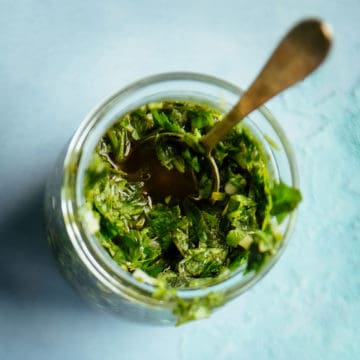

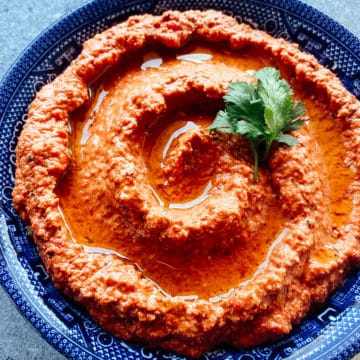
Comments
No Comments